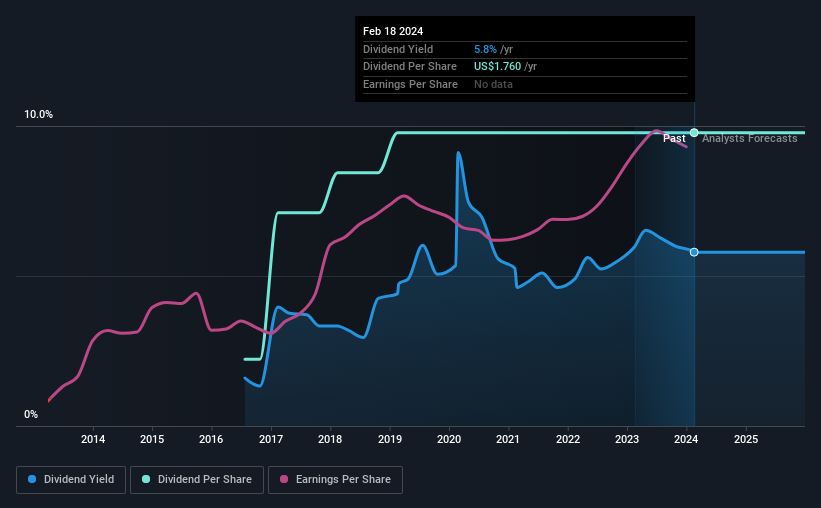Why You Might Be Interested In The Bank of N.T. Butterfield & Son Limited (NYSE:NTB) For Its Upcoming Dividend
It looks like The Bank of N.T. Butterfield & Son Limited (NYSE:NTB) is about to go ex-dividend in the next four days. Typically, the ex-dividend date is one business day before the record date which is the date on which a company determines the shareholders eligible to receive a dividend. The ex-dividend date is of consequence because whenever a stock is bought or sold, the trade takes at least two business day to settle. In other words, investors can purchase Bank of N.T. Butterfield & Son's shares before the 23rd of February in order to be eligible for the dividend, which will be paid on the 11th of March.
The company's upcoming dividend is US$0.44 a share, following on from the last 12 months, when the company distributed a total of US$1.76 per share to shareholders. Looking at the last 12 months of distributions, Bank of N.T. Butterfield & Son has a trailing yield of approximately 5.8% on its current stock price of US$30.37. We love seeing companies pay a dividend, but it's also important to be sure that laying the golden eggs isn't going to kill our golden goose! That's why we should always check whether the dividend payments appear sustainable, and if the company is growing.
See our latest analysis for Bank of N.T. Butterfield & Son
Dividends are typically paid from company earnings. If a company pays more in dividends than it earned in profit, then the dividend could be unsustainable. That's why it's good to see Bank of N.T. Butterfield & Son paying out a modest 38% of its earnings.
When a company paid out less in dividends than it earned in profit, this generally suggests its dividend is affordable. The lower the % of its profit that it pays out, the greater the margin of safety for the dividend if the business enters a downturn.
Click here to see the company's payout ratio, plus analyst estimates of its future dividends.
Have Earnings And Dividends Been Growing?
Stocks in companies that generate sustainable earnings growth often make the best dividend prospects, as it is easier to lift the dividend when earnings are rising. Investors love dividends, so if earnings fall and the dividend is reduced, expect a stock to be sold off heavily at the same time. With that in mind, we're encouraged by the steady growth at Bank of N.T. Butterfield & Son, with earnings per share up 5.7% on average over the last five years.
Many investors will assess a company's dividend performance by evaluating how much the dividend payments have changed over time. In the past eight years, Bank of N.T. Butterfield & Son has increased its dividend at approximately 20% a year on average. It's encouraging to see the company lifting dividends while earnings are growing, suggesting at least some corporate interest in rewarding shareholders.
To Sum It Up
Is Bank of N.T. Butterfield & Son worth buying for its dividend? Bank of N.T. Butterfield & Son has seen its earnings per share grow slowly in recent years, and the company reinvests more than half of its profits in the business, which generally bodes well for its future prospects. We think this is a pretty attractive combination, and would be interested in investigating Bank of N.T. Butterfield & Son more closely.
In light of that, while Bank of N.T. Butterfield & Son has an appealing dividend, it's worth knowing the risks involved with this stock. Every company has risks, and we've spotted 2 warning signs for Bank of N.T. Butterfield & Son (of which 1 shouldn't be ignored!) you should know about.
A common investing mistake is buying the first interesting stock you see. Here you can find a full list of high-yield dividend stocks.
Have feedback on this article? Concerned about the content? Get in touch with us directly. Alternatively, email editorial-team (at) simplywallst.com.
This article by Simply Wall St is general in nature. We provide commentary based on historical data and analyst forecasts only using an unbiased methodology and our articles are not intended to be financial advice. It does not constitute a recommendation to buy or sell any stock, and does not take account of your objectives, or your financial situation. We aim to bring you long-term focused analysis driven by fundamental data. Note that our analysis may not factor in the latest price-sensitive company announcements or qualitative material. Simply Wall St has no position in any stocks mentioned.

